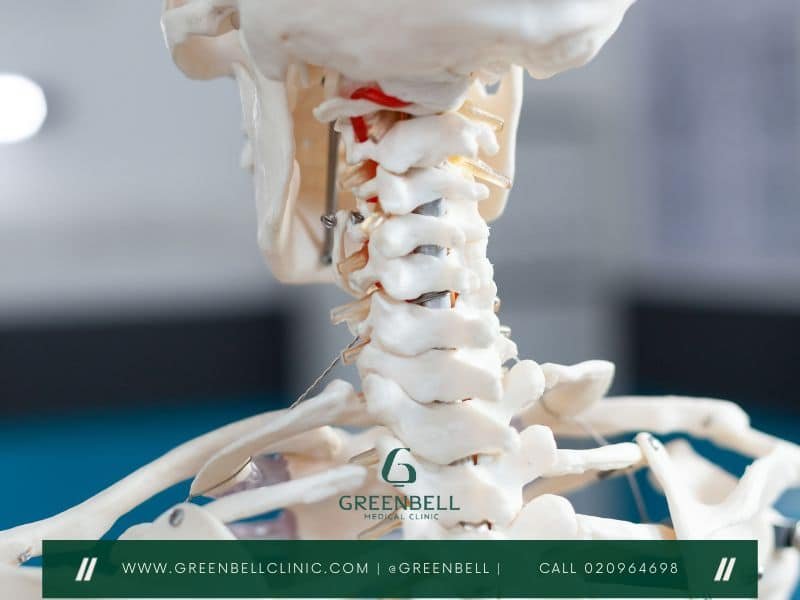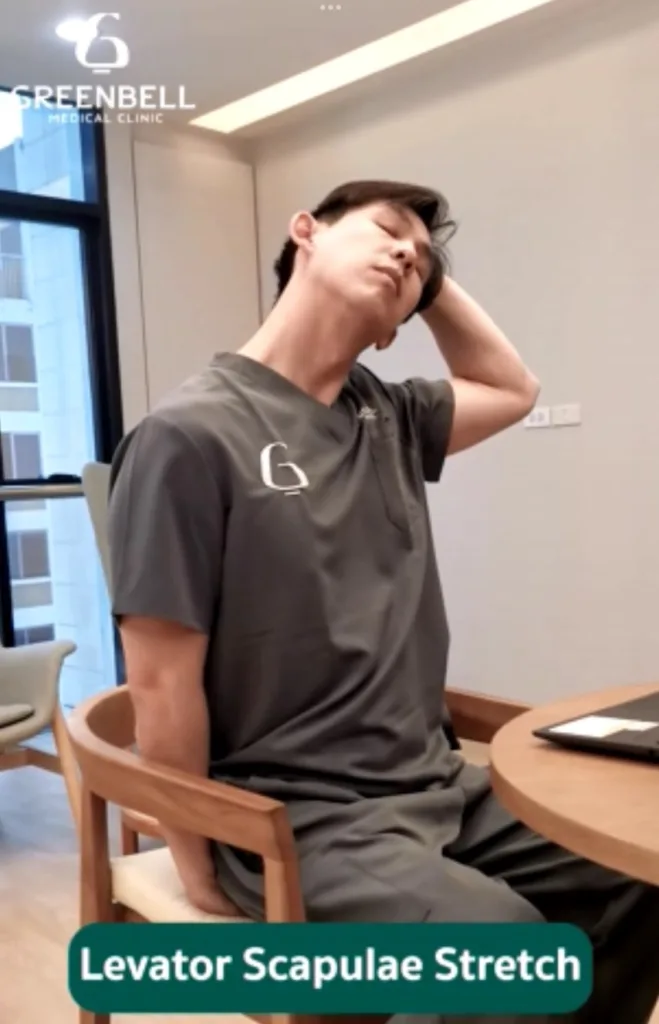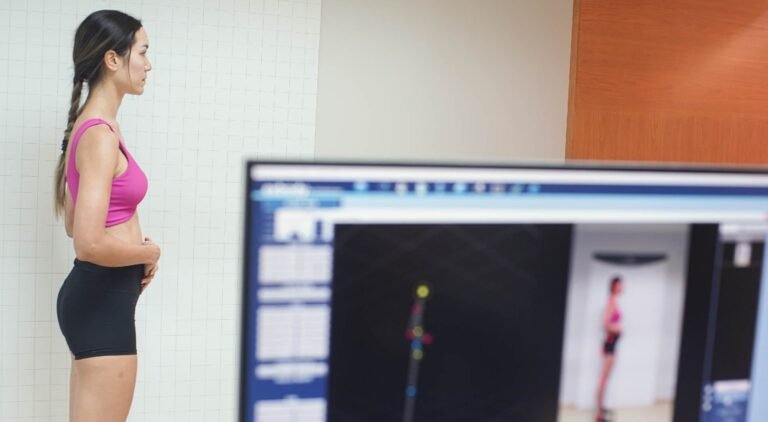Do you feel a nagging pain at the base of your skull that spreads to your forehead? You might be dealing with cervicogenic headaches. These headaches come from neck problems and can really mess up your day. In Thailand, long work hours and bad posture are making these headaches more common.
Neck pain often goes hand in hand with these headaches, making simple tasks a real challenge. But don’t worry! Understanding what causes these headaches is the first step toward finding relief. In this article, we’ll dive into the world of cervicogenic headaches, exploring their causes and the best ways to get that much-needed headache relief.
Key Takeaways
- Cervicogenic headaches originate from neck issues
- Poor posture and long work hours can trigger these headaches
- Neck pain is a common symptom accompanying the headache
- Understanding the causes is crucial for effective treatment
- Various relief options are available for cervicogenic headaches

Understanding Cervicogenic Headaches
Cervicogenic headaches come from neck problems. They cause pain that feels like other headaches. It’s hard to tell them apart from tension headaches and migraines.
Definition and Characteristics
Cervicogenic headaches start in the neck. The pain goes from the back of the head to the front. Unlike migraines, they don’t make you feel sick or sensitive to light.
Differentiating from Other Headache Types
It’s important to know the difference between cervicogenic headaches and others. Here’s a quick guide:
| Feature | Cervicogenic Headache | Tension Headache | Migraine |
|---|---|---|---|
| Pain Location | One-sided, starts in neck | Both sides of head | One or both sides |
| Pain Type | Dull, aching | Pressure-like | Throbbing |
| Neck Movement | Worsens pain | No effect | No effect |
| Associated Symptoms | Neck stiffness | Muscle tension | Nausea, light sensitivity |
Prevalence and Impact on Quality of Life
About 2.5% of adults have cervicogenic headaches. They can really mess up your day, making you less productive and less social. Getting the right treatment is key to feeling better.
Anatomy of the Cervical Spine and Its Role in Headaches
The cervical spine is key in supporting our head and allowing us to move our neck. It has seven vertebrae, labeled C1 to C7, connected by joints, ligaments, and muscles. Knowing this helps us see how problems in the cervical spine can cause headaches and neck stiffness.
The upper cervical spine, especially C1 and C2, is closely linked to the brainstem and trigeminal nerve. This connection is why issues in this area often lead to headaches. When these vertebrae are out of place or irritated, it can cause cervicogenic headaches.
Cervical spine disorders can also affect the nerves and blood vessels in the neck. This can send pain signals to the brain, leading to headaches. Common problems include:
- Herniated discs
- Spinal stenosis
- Osteoarthritis
- Muscle strain

Neck stiffness often goes hand in hand with these disorders, making it hard to move and worsening headache symptoms. Poor posture, long hours at a desk, or injuries can lead to both cervical spine issues and neck stiffness.
| Cervical Vertebrae | Function | Related Headache Symptoms |
|---|---|---|
| C1 (Atlas) | Supports head weight | Pain at base of skull |
| C2 (Axis) | Allows head rotation | Pain behind eyes |
| C3-C7 | Neck flexibility | Neck pain radiating to head |
Understanding the link between the cervical spine and headaches is crucial for treating and preventing cervicogenic headaches.
Common Causes of Cervicogenic Headaches
Cervicogenic headaches come from many sources, often linked to neck problems. Knowing what causes them can help prevent and treat them.
Neck Injuries and Trauma
Car accidents or sports injuries can lead to cervicogenic headaches. The sudden force can strain neck muscles and joints. This results in ongoing pain.
Poor Posture and Ergonomics
Working or texting for long periods can harm your neck. This bad posture leads to muscle tension. It causes headaches that start at the base of the skull.
Cervical Spine Disorders
Issues like herniated discs or arthritis in the neck can press nerves. This nerve compression often leads to pain that feels like a headache.
Myofascial Pain Syndrome
This chronic condition has trigger points in neck muscles. When these points are activated, they can send pain to the head. This causes severe discomfort.
| Cause | Common Symptoms | Prevention Tips |
|---|---|---|
| Neck Injuries | Stiffness, reduced range of motion | Wear protective gear during sports |
| Poor Posture | Neck pain, tension headaches | Use ergonomic office equipment |
| Cervical Spine Disorders | Radiating pain, numbness | Regular exercise, maintain healthy weight |
| Myofascial Pain Syndrome | Tender spots in muscles, referred pain | Stretch regularly, manage stress |
Knowing the causes helps find better treatments for cervicogenic headaches. Fixing neck problems often eases this headache type.
Recognizing Symptoms of Cervicogenic Headaches
Cervicogenic headaches can be hard to spot. They often look like other headaches but have their own signs. Knowing these symptoms is key to getting the right treatment.
The main symptom is pain in the neck that moves to the head. This pain usually hits one side and can be very strong. You might also feel stiff in your neck and have trouble moving it.
Here’s a breakdown of key symptoms:
- Pain starting at the base of the skull
- Neck stiffness and tenderness
- Pain behind the eyes
- Shoulder or arm discomfort
- Sensitivity to light or sound
- Nausea in some cases

How long these headaches last can vary. Some people get short, sharp pains, while others face pain that lasts for hours or even days.
| Symptom | Frequency | Intensity |
|---|---|---|
| Neck Pain | Very Common | Moderate to Severe |
| Headache | Always Present | Moderate to Severe |
| Neck Stiffness | Common | Mild to Moderate |
| Eye Pain | Sometimes | Mild to Moderate |
Spotting these symptoms is the first step to feeling better. If you often get these signs, see a doctor for a proper diagnosis and treatment plan.
Diagnosis Techniques for Cervicogenic Headaches
Figuring out cervicogenic headaches can be hard. Doctors use many ways to find out what’s causing your pain. Let’s look at the main methods they use to tell these headaches apart from migraines and tension headaches.
Physical Examination
Your doctor will start with a detailed physical exam. They’ll check how well your neck moves and find any sore spots. They might ask you to move your head in different ways to see if it hurts. This helps find neck problems that might be causing your headaches.
Imaging Studies
At times, a closer look inside is needed. X-rays can show bone issues, while MRI scans reveal soft tissue damage. CT scans might be used for more complex problems. These tests help confirm cervicogenic headaches and rule out other conditions.
Differential Diagnosis
It’s important to tell cervicogenic headaches from other types. Your doctor will compare your symptoms with those of migraines and tension headaches. They’ll look at where the pain is, what triggers it, and any other symptoms you have. This ensures you get the right treatment for your headaches.
| Headache Type | Key Characteristics | Common Triggers |
|---|---|---|
| Cervicogenic | One-sided pain, starts in neck | Neck movement, poor posture |
| Migraine | Pulsing pain, often with nausea | Stress, certain foods, light |
| Tension | Band-like pressure around head | Stress, lack of sleep |
Getting the right diagnosis is crucial for effective treatment. By using these methods, your healthcare provider can create a plan to help your cervicogenic headaches.
Treatment Options for Cervicogenic Headaches
Cervicogenic headaches can be tough to deal with, but there are many ways to find relief. A plan made just for you is usually the most effective. Physical therapy is a big help in managing these headaches.
Medicines can also help with pain. You might try over-the-counter pain relievers or prescription drugs. Some people find nerve blocks or Botox injections helpful too.
Physical therapy includes:
- Neck exercises to improve strength and flexibility
- Manual techniques to reduce muscle tension
- Postural education to prevent future headaches
Other treatments like acupuncture and massage can also help. Many people find these methods very soothing and effective.
| Treatment Option | Effectiveness | Duration |
|---|---|---|
| Physical Therapy | High | Long-term |
| Medications | Moderate | Short-term |
| Alternative Therapies | Varies | Varies |
Making lifestyle changes can also help. Better sleep, stress management, and good posture can lessen headaches. Remember, what works for one person might not work for another. Talk to a healthcare expert to make a plan that’s right for you.
Physical Therapy and Exercise for Headache Relief
Physical therapy is key in managing cervicogenic headaches and neck pain. It focuses on specific exercises and techniques. This helps patients find relief and improve their life quality.
Neck Strengthening Exercises
Strengthening the neck muscles supports the cervical spine and lowers headache frequency. Try these simple exercises:
- Chin tucks: Gently pull your chin towards your chest, hold for 5 seconds
- Isometric neck presses: Place your hand on your forehead and press against it without moving your head
- Neck rotations: Slowly turn your head from side to side
Postural Correction Techniques
Poor posture often leads to neck pain and headaches. Physical therapists teach patients to:
- Sit with shoulders back and chin tucked
- Use ergonomic workstations
- Take frequent breaks from prolonged sitting

Manual Therapy Approaches
Hands-on techniques offer immediate relief and improve neck mobility:
| Technique | Benefits |
|---|---|
| Cervical mobilization | Improves joint mobility, reduces pain |
| Soft tissue massage | Relieves muscle tension, increases blood flow |
| Trigger point therapy | Targets specific pain areas, reduces referred pain |
Combining these physical therapy approaches can lead to long-lasting headache relief and improved neck function. Patients in Thailand seeking treatment for cervicogenic headaches should consult with a qualified physical therapist to develop a personalized treatment plan.
Lifestyle Changes to Prevent Cervicogenic Headaches
Making smart lifestyle changes can really help with neck stiffness and headache relief. For those with cervicogenic headaches, these changes can be a big help. They can make managing symptoms easier and improve your quality of life.
Proper posture is very important. Keep your chin tucked and shoulders back when sitting or standing. This helps avoid straining your neck muscles. Make sure to take breaks from desk work to stretch and move around. Set reminders on your phone if you need to.
Sleep position is also key. Use a supportive pillow that keeps your neck in a neutral position. Try not to sleep on your stomach, as it can twist your neck in an unnatural way.
Stay hydrated and eat a balanced diet. Dehydration can cause headaches, and some foods might make symptoms worse. Keep a food diary to find out what might trigger your headaches.
Managing stress is also crucial. Try relaxation techniques like deep breathing or meditation. Regular exercise, especially gentle neck stretches, can help ease tension and improve flexibility.
| Lifestyle Change | Benefit |
|---|---|
| Improve posture | Reduces neck strain |
| Use proper pillow | Supports neutral neck position |
| Stay hydrated | Prevents dehydration-related headaches |
| Manage stress | Decreases muscle tension |
By making these lifestyle changes, you can take proactive steps to manage cervicogenic headaches. This can improve your overall well-being.
Conclusion
Cervicogenic headaches can really disrupt your day. But, finding relief is possible with the right approach. Knowing what causes and symptoms are important for effective treatment.
From neck injuries to bad posture, tackling the source can help a lot. A combination of physical therapy, exercises, and lifestyle changes often works best. Neck strengthening and improving posture can make a big difference.
Every person’s situation is different. So, it’s vital to work with healthcare experts to get a plan that fits you. This way, you can manage your headaches better.
By being proactive and trying different treatments, you can take back control. With time and effort, managing headaches becomes easier. This leads to a better life and more well-being.





